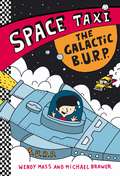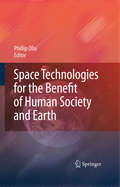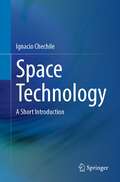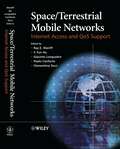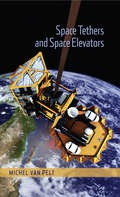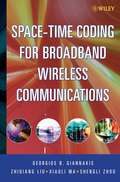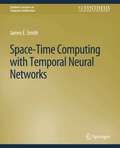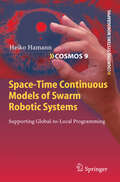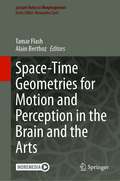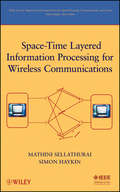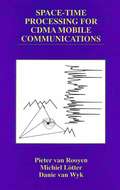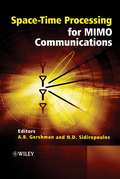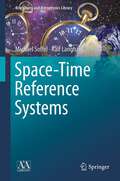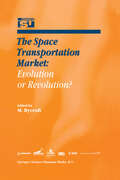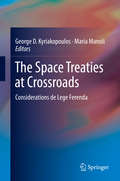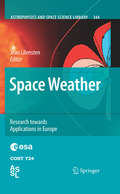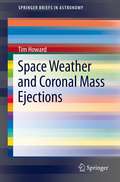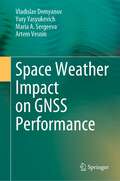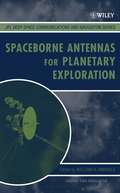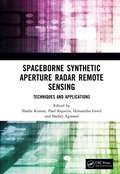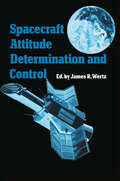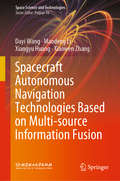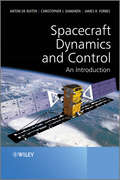- Table View
- List View
Space Taxi: The Galactic B.U.R.P. (Space Taxi #4)
by Michael Brawer Wendy MassIn this fourth book in the series, Archie is taken to the criminal organization B.U.R.P.'s mothership where he must outsmart evil masterminds! Archie Morningstar's dad drives a taxi through outer space! And with the help of a talking cat named Pockets, Archie and his dad help fight crime across the universe.
Space Technologies for the Benefit of Human Society and Earth
by Phillip OllaOverview of Space Technology It has been over 50 years since the rst satellite was sent into orbit, and the impact of space technology can be felt in many aspects in our day to day life. In addition to the convenience of knowing exactly where we are on the planet via GPS satellites; or deciding what to pack for a trip based on forecasts from weather satellites; watching CNNinaremotevillageviabroadcasting satellites;therearenowsomecrucialen- ronmental uses of Space technologies in the areas of natural resources management and environmental monitoring. Remotely sensed data reveals an unparallel view of the Earth for systems that require synoptic or periodic observations such as inv- tory control, surveying, agriculture, business, mineralogy, hydrography, geology, land mass cover, land utilization and environment monitoring. The advancement of remote sensing has made remote sensed data more affordable and available to merge with a variety of data sources to create mash-ups. The amalgamation of these data sources into disciplines such as agriculture, urban planning, web applications, cartography, geodetic reference systems, and global navigation satellite systems, are an important advancement of space applications and space science. Space Technology and Millennium Development Goals (MDGs) The MDGs are a set of time-bound, measurable goals and targets that are global as well as country-speci c for combating poverty, hunger, diseases, illiteracy, envir- mental degradation and discrimination against women.
Space Technology: A Short Introduction
by Ignacio ChechileThis engaging and accessible book is designed as a quick and easy way to get up to speed on all things in space technology. It also offers extensive references and links that allow readers to delve deeper into the subject.Whether you were a newcomer to space technology or a seasoned professional, this book is the best way to brush up on the basics of everything from satellite design and construction to the physics behind objects orbiting celestial bodies.Written in an accessible tone that is easy to understand, this book is perfect for reading during a short flight or any other spare moment you might have. You can learn about the main laws of Physics behind objects in orbit, the environments that satellites face while in space, and the processes involved in designing and building these incredible machines. Along the way, you can also get a glimpse into the history of space technology, including the foundational technologies that have made it all possible. So why not join the community of space enthusiasts and get up to speed on everything you need to know about space technology?
Space/Terrestrial Mobile Networks: Internet Access and QoS Support
by Ray E. Sheriff Y. Fun Hu Giacinto Losquadro Paolo Conforto Clementina TocciSpace/Terrestrial Mobile Networks Internet Access and QoS Support covers the design of a Global Mobile Broadband System (GMBS) based on the results of the European Commission's Framework Programme 5 Information Society Technologies (IST) Project SUITED. Many of the latest concept in mobility solutions, network design techniques and internet technologies are presented. The SUITED project has addressed a number of technical issues that are very much state-of-the-art. The presentation of such material in the form of a design of a real network provides a unique source of information. This book: Addresses the important topic of heterogeneous networks and the underlying tecyhnologies Describes how to design an integrated satellite/terrestrial infrastructure where all the network components are fully merged together and integrated with the Internet Core network Presents the service scenarios and system requirements of the Global Mobile Broadband System (GMBS) Discusses the necessary QoS support and defines the novel admission control scheme Gauge & Gate Reservation with Independent Probing (GRIP) Covers mobility management including Mobile-IP support and a QoS Support Module (QASM) Describes the functional and network architectures and presents signalling protocols for mobility management in GMBS Presents the design of signalling protocols and their implementation using the Specification and Description Language (SDL) Space/Terrestrial Mobile Networks Internet Access and QoS Support has an accessible and practical approach to the subject and addresses in detail, the important topic of heterogeneous networks and the underlying technologies that make this concept possible.
Space Tethers and Space Elevators
by Michel van PeltMichel van Pelt explains for the first time the principle of space tethers: what they are and how they can be used in space. He introduces non-technical space enthusiasts to the various possibilities and feasibility of space tethers including the technological challenges and potential benefits. He illustrates how, because of their inherent simplicity, space tethers have the potential to make space travel much cheaper, while ongoing advances in tether material technology may make even seemingly far-fetched ideas a reality in the not too distant future.
Space-Time Coding for Broadband Wireless Communications
by Georgios B. Giannakis Zhiqiang Liu Xiaoli Ma Sheng ZhouThis is the first book on space-time coding for wireless communications, one of the most promising techniques for ensuring bandwidth efficiency. The text describes theoretical principles as well as engineering applications; discusses key criteria in the design of practical space-time codes; and covers single-carrier and multi-carrier transmission for both single- and multi-user communications.
Space-Time Computing with Temporal Neural Networks (Synthesis Lectures on Computer Architecture)
by James E. SmithUnderstanding and implementing the brain's computational paradigm is the one true grand challenge facing computer researchers. Not only are the brain's computational capabilities far beyond those of conventional computers, its energy efficiency is truly remarkable. This book, written from the perspective of a computer designer and targeted at computer researchers, is intended to give both background and lay out a course of action for studying the brain's computational paradigm. It contains a mix of concepts and ideas drawn from computational neuroscience, combined with those of the author. As background, relevant biological features are described in terms of their computational and communication properties. The brain's neocortex is constructed of massively interconnected neurons that compute and communicate via voltage spikes, and a strong argument can be made that precise spike timing is an essential element of the paradigm. Drawing from the biological features, a mathematics-based computational paradigm is constructed. The key feature is spiking neurons that perform communication and processing in space-time, with emphasis on time. In these paradigms, time is used as a freely available resource for both communication and computation. Neuron models are first discussed in general, and one is chosen for detailed development. Using the model, single-neuron computation is first explored. Neuron inputs are encoded as spike patterns, and the neuron is trained to identify input pattern similarities. Individual neurons are building blocks for constructing larger ensembles, referred to as "columns". These columns are trained in an unsupervised manner and operate collectively to perform the basic cognitive function of pattern clustering. Similar input patterns are mapped to a much smaller set of similar output patterns, thereby dividing the input patterns into identifiable clusters. Larger cognitive systems are formed by combining columns into a hierarchical architecture. These higher level architectures are the subject of ongoing study, and progress to date is described in detail in later chapters. Simulation plays a major role in model development, and the simulation infrastructure developed by the author is described.
Space-Time Continuous Models of Swarm Robotic Systems: Supporting Global-to-Local Programming (Cognitive Systems Monographs #9)
by Heiko HamannIn this book, a generic model in as far as possible mathematical closed-formis developed that predicts the behavior of large self-organizing robot groups (robot swarms) based on their control algorithm. In addition, an extensive subsumption of the relatively young and distinctive interdisciplinary research field of swarm robotics is emphasized. The connection to many related fields is highlighted and the concepts and methods borrowed from these fields are described shortly.
Space-Time Geometries for Motion and Perception in the Brain and the Arts (Lecture Notes in Morphogenesis)
by Tamar Flash Alain BerthozThis book is based on a two-day symposium at the Paris Institute of Advanced Study titled "space-time geometries and movement in the brain and the arts". It includes over 20 chapters written by the leading scientists and artists who presented their related research studies at the symposium and includes six sections; the first three focus on space-time geometries in perception, action and memory while the last three focus on specific artistic domains: drawing and painting, dance, music, digital arts and robotics. The book is accompanied by a dedicated webpage including related images and videos. There is an ever-growing interest in the topics covered by this book. Space and time are of fundamental importance for our understanding of human perception, action, memory and cognition, and are entities which are equally important in physics, biology, neuroscience and psychology. Highly prominent scientists and mathematicians have expressed their belief that our bodies and minds shape the ways we perceive space and time and the physical laws we formulate. Understanding how the brain perceives motion and generates -bodily movements is of great significance. There is also growing interest in studying how space, time and movement subserve artistic creations in different artistic modalities (e.g., fine arts, digital and performing arts and music). This interest is inspired by the idea that artists make intuitive use of the principles and simplifying strategies used by the brain in movement generation and perception. Building upon new understanding of the spatio-temporal geometries subserving movement generation and perception by the brain we can start exploring how artists make use of such neuro --geometrical and neuro-dynamic representations in order to express artistic concepts and emotionally affect the human observers and listeners. Scientists have also started formulating new ideas of how aesthetic judgements emerge from the principles and brain mechanisms subserving motor control and motion perception.Covering novel and multidisciplinary topics, this advanced book will be of interest to neuroscientists, behavioral scientists, artificial intelligence and robotics experts, students and artists.
Space-Time Layered Information Processing for Wireless Communications (Adaptive and Cognitive Dynamic Systems: Signal Processing, Learning, Communications and Control #30)
by Mathini Sellathurai Simon HaykinDiscover cutting-edge research in wireless communications This book presents cutting-edge research in wireless communications, particularly in the fast-growing subject of multiple-input multiple-output (MIMO) wireless communication systems. It begins with an introduction, which includes historical notes and a review of turbo-information processing and MIMO wireless communications, and goes on to cover: * MIMO channel capacity * BLAST architectures * Space-time turbo codes and turbo decoding principles * Turbo-BLAST * Turbo-MIMO systems The material is complemented with abundant illustrations and computer experiments that are designed to help readers reinforce their understanding of the underlying subject matter. Space-Time Layered Information Processing for Wireless Communications is an ideal resource for researchers in academia and industry and an excellent textbook for related courses at the graduate level.
Space-Time Processing for CDMA Mobile Communications (The Springer International Series in Engineering and Computer Science #544)
by Pieter van Rooyen Michiel P. Lötter Danie van WykSpace-Time Processing for CDMA Mobile Communications is one of the first books to: bring together spatial/temporal channel models and analytic performance evaluation techniques; establish a link between smart antenna systems and advanced receiver design techniques; treat smart antennas specifically for UMTS-like communication systems, with applicable simulations and calculations; supply code with Matlab® GUI so readers can run or modify existing simulations or create new ones. The field of smart antenna technology or, more generally, space-time processing is rapidly becoming one of the most promising areas of mobile communications, especially regarding the development of the first practical third-generation mobile communication systems. The authors have addressed many of the most basic questions relating to the use of space-time processing in CDMA-based third-generation systems and have presented models for the integration of space-time processing, error correction coding, and multi-user detection techniques. Included is extensive background information on cellular systems, antenna array theory, smart antenna techniques, performance of basic space-time processors and advanced space-time processors. The book also includes an extensive simulation program written in Matlab®. The simulation code implements both the uplink and the downlink of a UMTS-like communication system. This provides multiple options for simulating system performance using a variety of channel models as well as receiver structures. Space-Time Processing for CDMA Mobile Communications will be an invaluable reference work for engineers and researchers, and a useful source for design engineers enabling them to understand the implications of adding space-time processing systems to CDMA-based communication systems.
Space-Time Processing for MIMO Communications
by Alex Gershman Nikos SidiropoulosDriven by the desire to boost the quality of service of wireless systems closer to that afforded by wireline systems, space-time processing for multiple-input multiple-output (MIMO) wireless communications research has drawn remarkable interest in recent years. Exciting theoretical advances have been complemented by rapid transition of research results to industry products and services, thus creating a vibrant new area. Space-time processing is a broad area, owing in part to the underlying convergence of information theory, communications and signal processing research that brought it to fruition. This book presents a balanced and timely introduction to space-time processing for MIMO communications, including highlights of emerging trends, such as spatial multiplexing and joint transceiver optimization. Includes detailed coverage of wireless channel sounding, modelling, characterization and model validation. Provides state-of-the-art research results on space-time coding, including comprehensive tutorial coverage of orthogonal space-time block codes. Discusses important recent developments in spatial multiplexing, transmit beam-forming, pre-coding and joint transceiver design for the multi-user MIMO downlink using full or partial CSI. Illustrates all theory with numerous examples gleaned from cutting-edge research from around the globe. This valuable resource will appeal to engineers, developers and consultants involved in the design and implementation of space-time processing for MIMO communications. Its accessible format, amply illustrated with real world case studies, contains relevant, detailed advice for postgraduate students and researchers specializing in this field.
Space-Time Reference Systems (Astronomy and Astrophysics Library)
by Michael Soffel Ralf LanghansThe high accuracy of modern astronomical spatial-temporal reference systems has made them considerably complex. This book offers a comprehensive overview of such systems. It begins with a discussion of ‘The Problem of Time’, including recent developments in the art of clock making (e.g., optical clocks) and various time scales. The authors address the definitions and realization of spatial coordinates by reference to remote celestial objects such as quasars. After an extensive treatment of classical equinox-based coordinates, new paradigms for setting up a celestial reference system are introduced that no longer refer to the translational and rotational motion of the Earth. The role of relativity in the definition and realization of such systems is clarified.The topics presented in this book are complemented by exercises (with solutions). The authors offer a series of files, written in Maple, a standard computer algebra system, to help readers get a feel for the various models and orders of magnitude. Beyond astrometry, the main fields of application of high-precision astronomical spatial-temporal reference systems and frames are navigation (GPS, interplanetary spacecraft navigation) and global geodynamics, which provide a high-precision Celestial Reference System and its link to any terrestrial spatial-temporal reference system. Mankind’s urgent environmental questions can only be answered in the context of appropriate reference systems in which both aspects, space and time, are realized with a sufficiently high level of accuracy. This book addresses all those interested in high-precision reference systems and the various techniques (GPS, Very Long Baseline Interferometry, Satellite Laser Ranging, Lunar Laser Ranging) necessary for their realization, including the production and dissemination of time signals.
The Space Transportation Market: Evolution or Revolution? (Space Studies #5)
by Michael J. RycroftM. Rycroft, FacultyMember, InternationalSpaceUniversity e-mail:Rycroft@isu.isunet.edu "The Space Transportation Market: Evolution or Revolution?" was the question which was the focus for the papers presented, and also the Panel Discussions, at the fifth annual Symposium organised by the International Space University. Held in Strasbourg, France, for three lively days at the end of May 2000, the Symposium brought together representatives of the developers, providers and operators of space transportation systems, of regulatory bodies, and of users of the space transportation infrastructure in many fields, as well as experts in policy and market analysis. From the papers published here, it is clear that today's answer to the question tends more towards evolution than to revolution. The space launch industry is still not a fully mature one, and is still reliant on at least partial funding by governments. Better cooperation is essential between governments, launch providers, satellite builders and satellite operators in order to reduce the problems which the space transportation market faces today.
The Space Treaties at Crossroads: Considerations de Lege Ferenda
by George D. Kyriakopoulos Maria ManoliThis contributed volume addresses the future development of space law in light of our ever-growing space activities, the multiplicity of new space actors and the challenges posed by novel space technologies. Unlike existing space law literature, it sets its sights on the future, envisaging how space law could and should evolve in coming decades. Written by experienced professors, academics and practitioners in the field, this edited volume constitutes a valuable tool for understanding the current state of space law, the challenges it is called upon to address and the new phase it is about to enter. In addition, this book initiates a discussion de lege ferenda, addressing the letter and spirit of space law in the world of modern and future space activities. These papers were presented at “The Space Treaties at Crossroads: Considerations de lege ferenda,” held on August 28 to 29, 2015, in Athens, Greece. The conference was jointly organized by the National and Kapodistrian University of Athens and the Institute of Air and Space Law of McGill University
Space Weather: Research Towards Applications in Europe (Astrophysics and Space Science Library #344)
by Jean LilenstenThis book shows the state-of-the-art in Europe on a very new discipline, Space Weather. This discipline lies at the edge between science and industry. This book reflects such a position with theoretic papers and applicative papers as well. Each chapter starts with a short introduction, which shows the coherence of a given domain. Then, four to five contributions written by the best specialists in Europe give detailed hints of a hot topic in space weather.
Space Weather and Coronal Mass Ejections (SpringerBriefs in Astronomy)
by Tim HowardSpace weather has attracted a lot of attention in recent times. Severe space weather can disrupt spacecraft, and on Earth can be the cause of power outages and power station failure. It also presents a radiation hazard for airline passengers and astronauts. These “magnetic storms” are most commonly caused by coronal mass ejections, or CMES, which are large eruptions of plasma and magnetic field from the Sun that can reach speeds of several thousand km/s. In this SpringerBrief, Space Weather and Coronal Mass Ejections, author Timothy Howard briefly introduces the coronal mass ejection, its scientific importance, and its relevance to space weather at Earth and other planets. This title focuses on the latest advances in CME observation and modeling, including new results from the NASA STEREO and SDO missions. It also includes topical issues regarding space weather and the most recent observations and anecdotal examples of the impacts of space weather and CMEs.
Space Weather, Environment and Societies
by Jean Lilensten Jean BornarelOur planet exists within a space environment affected by constantly changing solar atmosphere producing cosmic particles and electromagnetic waves. This "space weather" profoundly influences the performance of our technology because we primarily use two means for transmitting information and energy; namely, electromagnetic waves and electricity. On an everyday basis, we have developed methods to cope with the normal conditions. However, the sun remains a fiery star whose 'angry' outbursts can potentially destroy spacecrafts, kill astronauts, melt electricity transformers, stop trains, and generally wreak havoc with human activities. Space Weather is the developing field within astronomy that aims at predicting the sun’s violent activity and minimizing the impacts on our daily lives. Space Weather, Environment, and Societies explains why our technological societies are so dependent on solar activity and how the Sun disturbs the transmission of information and energy. Footnotes expand specific points and the appendices facilitate a more thorough command of the physics involved.
Space Weather Impact on GNSS Performance
by Vladislav Demyanov Yury Yasyukevich Maria A. Sergeeva Artem VesninThis book addresses problems of GNSS performance support under geomagnetic storms and solar radio bursts. It analyses both physical and radio-engineering sources of GNSS performance deterioration caused by geomagnetic storms, solar radio bursts and peculiarities of the polar and equatorial ionosphere. The book takes into consideration both standalone GNSS and differential GNSS. Based on experimental data analysis, it presents a systematic approach to maintaining reliable GNSS performance despite the Space Weather impacts.Given its scope, the book offers a valuable resource for GNSS users and equipment developers, as well as researchers and students whose work involves GNSS remote sensing, surveying, navigation, and related disciplines.
Spaceborne Antennas for Planetary Exploration (JPL Deep-Space Communications and Navigation Series #12)
by Joseph H. YuenJPL spacecraft antennas-from the first Explorer satellite in 1958 to current R & D Spaceborne Antennas for Planetary Exploration covers the development of Jet Propulsion Laboratory (JPL) spacecraft antennas, beginning with the first Explorer satellite in 1958 through current research and development activities aimed at future missions. Readers follow the evolution of all the new designs and technological innovations that were developed to meet the growing demands of deep space exploration. The book focuses on the radio frequency design and performance of antennas, but covers environmental and mechanical considerations as well. There is additionally a thorough treatment of all the analytical and measurement techniques used in design and performance assessment. Each chapter is written by one or more leading experts in the field of antenna technology. The presentation of the history and technology of spaceborne antennas is aided by several features: * Photographs and drawings of JPL spacecraft * Illustrations to help readers visualize concepts and designs * Tables highlighting and comparing the performance of the antennas * Bibliographies at the end of each chapter leading to a variety of primary and secondary source material This book complements Large Antennas of the Deep Space Network (Wiley 2002), which surveys the ground antennas covered in support of spacecraft. Together, these two books completely cover all JPL antenna technology, in keeping with the JPL Deep Space Communications and Navigation Series mission to capture and present the many innovations in deep space telecommunications over the past decades. This book is a fascinating and informative read for all individuals working in or interested in deep space telecommunications.
Spaceborne Synthetic Aperture Radar Remote Sensing: Techniques and Applications
by Shashi Kumar Paul Siqueira Himanshu Govil Shefali AgrawalThis book provides basic and advanced concepts of synthetic aperture radar (SAR), PolSAR, InSAR, PolInSAR, and all necessary information about various applications and analysis of data of multiple sensors. It includes information on SAR remote sensing, data processing, and separate applications of SAR technology, compiled in one place. It will help readers to use active microwave imaging sensor-based information in geospatial technology and applications.This book: Covers basic and advanced concepts of synthetic aperture radar (SAR) remote sensing Introduces spaceborne SAR sensors Discusses applications of SAR remote sensing in earth observation Explores utilization of SAR data for solid earth, ecosystem, and cryosphere, including imaging of extra-terrestrial bodies Includes PolSAR and PolInSAR for aboveground forest biomass retrieval, as well as InSAR and PolSAR for snow parameters retrieval This book is aimed at researchers and graduate students in remote sensing, photogrammetry, geoscience, image processing, agriculture, environment, forestry, and image processing.
Spaceborne Synthetic Aperture Radar Remote Sensing: Techniques and Applications
by Shashi Kumar Paul Siqueira Himanshu Govil Shefali AgrawalThis book provides basic and advanced concepts of synthetic aperture radar (SAR), PolSAR, InSAR, PolInSAR, and all necessary information about various applications and analysis of data of multiple sensors. It includes information on SAR remote sensing, data processing, and separate applications of SAR technology, compiled in one place. It will help readers to use active microwave imaging sensor-based information in geospatial technology and applications.This book: Covers basic and advanced concepts of synthetic aperture radar (SAR) remote sensing Introduces spaceborne SAR sensors Discusses applications of SAR remote sensing in earth observation Explores utilization of SAR data for solid earth, ecosystem, and cryosphere, including imaging of extra-terrestrial bodies Includes PolSAR and PolInSAR for aboveground forest biomass retrieval, as well as InSAR and PolSAR for snow parameters retrieval This book is aimed at researchers and graduate students in remote sensing, photogrammetry, geoscience, image processing, agriculture, environment, forestry, and image processing.
Spacecraft Attitude Determination and Control (Astrophysics and Space Science Library #73)
by J. R. WertzRoger D. Werking Head, Attitude Determination and Control Section National Aeronautics and Space Administration/ Goddard Space Flight Center Extensiye work has been done for many years in the areas of attitude determination, attitude prediction, and attitude control. During this time, it has been difficult to obtain reference material that provided a comprehensive overview of attitude support activities. This lack of reference material has made it difficult for those not intimately involved in attitude functions to become acquainted with the ideas and activities which are essential to understanding the various aspects of spacecraft attitude support. As a result, I felt the need for a document which could be used by a variety of persons to obtain an understanding of the work which has been done in support of spacecraft attitude objectives. It is believed that this book, prepared by the Computer Sciences Corporation under the able direction of Dr. James Wertz, provides this type of reference. This book can serve as a reference for individuals involved in mission planning, attitude determination, and attitude dynamics; an introductory textbook for stu dents and professionals starting in this field; an information source for experimen ters or others involved in spacecraft-related work who need information on spacecraft orientation and how it is determined, but who have neither the time nor the resources to pursue the varied literature on this subject; and a tool for encouraging those who could expand this discipline to do so, because much remains to be done to satisfy future needs.
Spacecraft Autonomous Navigation Technologies Based on Multi-source Information Fusion (Space Science and Technologies)
by Dayi Wang Maodeng Li Xiangyu Huang Xiaowen ZhangThis book introduces readers to the fundamentals of estimation and dynamical system theory, and their applications in the field of multi-source information fused autonomous navigation for spacecraft. The content is divided into two parts: theory and application. The theory part (Part I) covers the mathematical background of navigation algorithm design, including parameter and state estimate methods, linear fusion, centralized and distributed fusion, observability analysis, Monte Carlo technology, and linear covariance analysis. In turn, the application part (Part II) focuses on autonomous navigation algorithm design for different phases of deep space missions, which involves multiple sensors, such as inertial measurement units, optical image sensors, and pulsar detectors. By concentrating on the relationships between estimation theory and autonomous navigation systems for spacecraft, the book bridges the gap between theory and practice. A wealth of helpful formulas and various types of estimators are also included to help readers grasp basic estimation concepts and offer them a ready-reference guide.
Spacecraft Dynamics and Control: An Introduction
by Anton H. de Ruiter Christopher Damaren James R. ForbesProvides the basics of spacecraft orbital dynamics plus attitude dynamics and control, using vectrix notation Spacecraft Dynamics and Control: An Introduction presents the fundamentals of classical control in the context of spacecraft attitude control. This approach is particularly beneficial for the training of students in both of the subjects of classical control as well as its application to spacecraft attitude control. By using a physical system (a spacecraft) that the reader can visualize (rather than arbitrary transfer functions), it is easier to grasp the motivation for why topics in control theory are important, as well as the theory behind them. The entire treatment of both orbital and attitude dynamics makes use of vectrix notation, which is a tool that allows the user to write down any vector equation of motion without consideration of a reference frame. This is particularly suited to the treatment of multiple reference frames. Vectrix notation also makes a very clear distinction between a physical vector and its coordinate representation in a reference frame. This is very important in spacecraft dynamics and control problems, where often multiple coordinate representations are used (in different reference frames) for the same physical vector. Provides an accessible, practical aid for teaching and self-study with a layout enabling a fundamental understanding of the subject Fills a gap in the existing literature by providing an analytical toolbox offering the reader a lasting, rigorous methodology for approaching vector mechanics, a key element vital to new graduates and practicing engineers alike Delivers an outstanding resource for aerospace engineering students, and all those involved in the technical aspects of design and engineering in the space sector Contains numerous illustrations to accompany the written text. Problems are included to apply and extend the material in each chapter Essential reading for graduate level aerospace engineering students, aerospace professionals, researchers and engineers.
